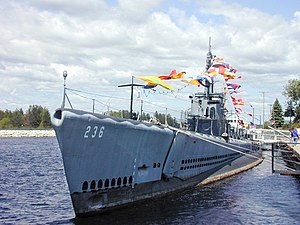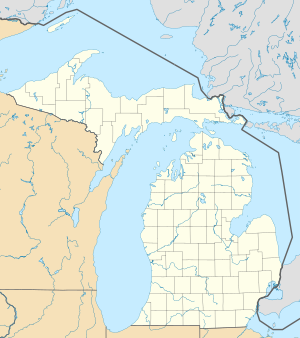USS Silversides (SS-236)

Silversides on or about 31 March 1942 as she was on sea trials
|
|
| History | |
|---|---|
|
|
|
| Builder: | Mare Island Naval Shipyard |
| Laid down: | 4 November 1940 |
| Launched: | 26 August 1941 |
| Sponsored by: | Elizabeth H. Hogan |
| Commissioned: | 15 December 1941 |
| Decommissioned: | 17 April 1946 |
| Struck: | 30 June 1969 |
| Status: | Museum ship at Muskegon, Michigan |
| General characteristics | |
| Class and type: | Gato-class diesel-electric submarine |
| Displacement: |
|
| Length: | 311 ft 9 in (95.02 m) |
| Beam: | 27 ft 3 in (8.31 m) |
| Draft: | 17 ft (5.2 m) maximum |
| Propulsion: |
|
| Speed: |
|
| Range: | 11,000 nmi (20,000 km; 13,000 mi) surfaced at 10 knots (19 km/h; 12 mph) |
| Endurance: |
|
| Test depth: | 300 ft (90 m) |
| Complement: | 6 officers, 54 enlisted |
| Armament: |
|
|
U.S.S. Silversides
|
|

Silversides, a national landmark and a museum, at "full dress ship" in Muskegon for the US Navy's Submarine Centennial, 3 June 2000
|
|
| Location | Muskegon, Michigan |
| Coordinates | 43°13′48″N 86°19′58″W / 43.23000°N 86.33278°WCoordinates: 43°13′48″N 86°19′58″W / 43.23000°N 86.33278°W |
| Built | 1941 |
| NRHP Reference # | 72000453 |
| Significant dates | |
| Added to NRHP | 18 October 1972 |
| Designated | 14 January 1962 |
USS Silversides (SS/AGSS-236) is a Gato-class submarine, the first ship of the United States Navy to be named for the silversides, a small fish marked with a silvery stripe along each side of its body.
Her keel was laid down on 4 November 1940 by the Mare Island Navy Yard in Vallejo, California. She was launched on 26 August 1941 (sponsored by Mrs. Elizabeth H. Hogan), and commissioned on 15 December 1941, with Lieutenant Commander Creed C. Burlingame (Class of 1927) in command.
After shakedown off the California coast, Silversides set course for Hawaii, arriving at Pearl Harbor on 4 April 1942. Departing Pearl Harbor on 30 April, Silversides headed for the Japanese home islands, in the area of Kii Suido, for the first of her many successful war patrols. On 10 May, just after 8:00 local time, the submarine used her 3-inch (76 mm) gun to heavily damage a Japanese gunboat. During this 75 minute action, an enemy machine-gun bullet killed one of her deck gunners, TM3 Mike Harbin, the only man lost in action aboard Silversides during World War II. Harbin was buried at sea later that evening. On 13 May, Silversides fired torpedoes at an enemy submarine; although explosions were heard, a definite sinking could not be confirmed.
On 17 May, while maneuvering through an enemy fishing fleet and approaching her targets, Silversides' periscope became entangled in a fishnet marked by Japanese flags held aloft on bamboo poles. The sub continued her approach, fishnet and all, and fired three torpedoes at the first ship, a 4,000-ton cargo ship. Two hits tore the victim's stern open. While that ship was sinking, the second cargo ship was also hit, but its fate could not be determined. Patrol boats were closing in as the submarine, probably the only American submarine to make an attack while flying the Japanese flag, quickly left the vicinity. After damaging a freighter and tanker in the same area, Silversides terminated her first war patrol at Pearl Harbor on 21 June.
...
Wikipedia

